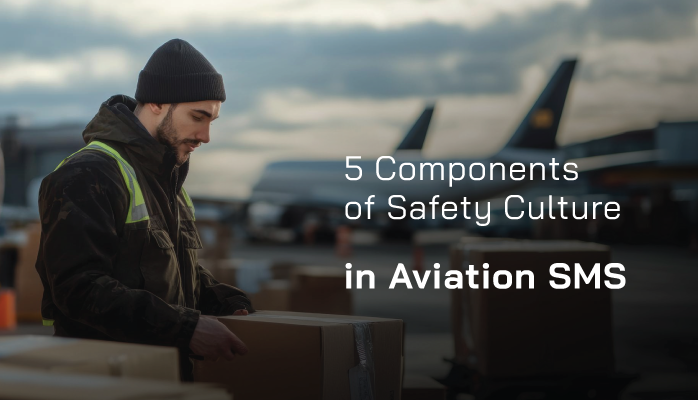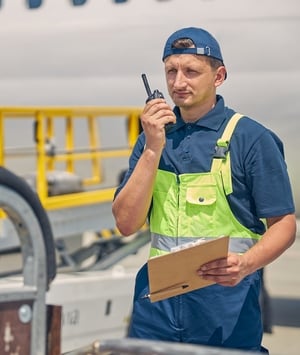What Is Safety Culture in Aviation SMS

There are many possible definitions of safety culture in aviation safety management systems (SMS). Generic definitions focus on:
- Attitudes;
- Behaviors; and
- Values.
While these points certainly are a core part of safety culture, they are also unhelpfully vague. What is more helpful is: What does safety culture look like in the operational environment?
Related Articles on Aviation Safety Culture
- What Is Safety Culture in the Aviation Industry?
- How to Build Safety Culture in Aviation SMS
- How Top Management Kills Aviation Safety Culture - With Examples
When looking at safety culture in this way, there are several things we must acknowledge:
- There are different "types" or "components" of safety culture;
- Safety culture can be measured by:
- specific actions
- specific occurrences
- specific data
- Safety culture correlates directly with safety performance.
Exploring these different aviation safety culture components and the ways safety culture can be measured is extremely helpful for understanding why an aviation SMS functions the way it does. Here are the 5 components of aviation safety culture.
1 - Safety (Hazard) Reporting Culture
- how developed your hazard reporting process is, as well as
- how frequently employees use that process to report safety concerns.
By "frequent" we are talking about the expected number of hazard reports submitted within a particular time period. Mature hazard reporting cultures see a historical, steady rise in the number of monthly hazard reports followed by a leveling off of hazard reports so that monthly safety reporting statistics are consistent.
Some ways to develop hazard reporting cultures are:
- Modern, highly accessible hazard reporting system in place;
- Risk management processes focusing on the incident and not people;
- Reported safety issues are managed in a timely manner with visible/transparent results;
- Multiple ways to report hazards (and are easy to use); and
- High-volume reporters are formally recognized by the company.
A couple of notes on the above points. Having multiple ways to report hazards, such as via email, cellphones, company website, etc., will undoubtedly improve hazard reporting numbers. Moreover, formally recognizing valuable contributors to the SMS also provides a good incentive for other employees to report.
Mature hazard reporting culture provides superior data acquisition and safety data.
Related Articles on Aviation Hazard Reporting Systems
- How to Develop a Hazard Reporting System in Aviation SMS [With Free Checklist]
- What Good Hazard Reporting Process Look Like in Mature Aviation SMS
- What Is Missing Most in Aviation Hazard Reporting Systems?
2 - Safety Awareness
Safety awareness (lack of awareness) is one of the 12 Dirty Dozen Human Factors, and indeed it very well may have the highest implication in most safety incidents. In simple terms, safety awareness is the ability to recognize the wide-ranging potential effects of one's actions on the operational environment.
Having good vigilance can literally be the difference between an accident and not. Some good indicators that an organization has good organizational safety awareness are:
- Most/all employees have received hazard identification training;
- Employees securely access detailed hazard occurrence data commensurate with their role in the aviation SMS;
- Stable workforce of experienced workers;
- Significant safety trends and data are communicated directly to employees;
- Checklists are regularly used for work tasks; and
- Policies, procedures, checklists, etc., have multiple language support where applicable.
You will notice that the above list includes some quality management items, such as having a stable workforce. There is no doubt that when organizations provide a non-toxic environment for employees to work, safety will improve simply because employees will have a more positive attitude that is better suited for safety.
As you attempt to raise safety awareness in your organization, consider how non-safety related-elements of worker's jobs may indirectly improve safety.
Human factors play an integral role in aviation SMS. Most root causes of accidents and incidents can be traced back to human factors. Aviation service providers that focus on the human element are more resistant to risk-related consequences as they practice their risk management processes.
Related Aviation Human Factors Articles
- Let’s Talk Human Factors - Origin of Dirty Dozen
- Let’s Talk Human Factors - Lack of Communication
- Let’s Talk Human Factors: Distraction Is #4 of the Dirty Dozen
3 - Safety Communication

Safety communication concerns how safety information flows between managers and employees of your organization. Ideally, safety information will flow freely between:
- Front line employees to front line employees;
- Front line employees to management; and
- Management to front-line employees.
Safety information is simply any information that affects safety, including
- safety communications resulting from identified hazards;
- hazard reporting data;
- safety behavior data;
- safety promotion media, such as newsletters, surveys, etc.;
- safety attitude data, and so on.
Some indicators of good safety communication in an organization are:
- Management encourages feedback;
- Management provides consistent, timely feedback;
- Evidence of employee involvement in aviation SMS process design and refinement;
- Safety management uses safety surveys and other forms of employee-opinion data collection;
- Organization holds regular safety meetings/briefings with employees and management;
- Management visibly active in safety promotion activities;
- Safety promotion activities are documented and spread out over the year to stimulate continued awareness;
- Past safety meetings are well documented and accessible to employees based on their role or job position; and
- Policies, procedures, checklists, etc., have multiple language support where applicable.
4 - Safety Willingness
Safety willingness is an extremely important part of a safety culture that tends to live in the shadow of communication and awareness. Willingness is simply how motivated employees (including management) are to:
- Follow safety program documentation, such as procedures, checklists, etc.;
- Accept changes to the SMS; and
- Be involved in the SMS.
Markers of good safety willingness in a company are:
- There is a clear accountability/reward system in place;
- Safety performance reviews are included in performance reviews;
- Management has distinct ways of promoting safety;
- Employee job satisfaction is high; and
- Management encourages safety over productivity (employees can stop work for safety reasons).
Safety willingness will greatly aid in the efficiency of aviation SMS implementation. Improving safety willingness in the aviation industry is most effective with a top-down approach. Management leads by example and is a vocal supporter of the SMS.
Your safety culture's level of willingness can be improved by safety champions at various levels within the organization. These safety champions are charismatic and infect your culture with their positive attitudes and dedication to improving "system safety." Safety champions at the line level are not as effective as an account executive or upper management support; however, do not discount their value. Just as a bad apple (resistant employee) can eat away and erode your safety culture, influential safety champions can positively shape safety cultures at the departmental level.
New aviation SMS implementations need safety champions at all levels to change attitudes toward the new way of doing business. Aviation SMS changes cultures from "we've always done it this way," to "how do we improve the system to make it more:"
- Safe;
- Economical;
- User-friendly; or
- Environmentally acceptable.
High-performing safety cultures look for opportunities, whereas poor-performing cultures stagnate or are constantly reacting to events due to resistant attitudes.
Related Articles on Improving Safety Culture
- How to Reduce Resistance to Aviation SMS With Difficult Employees
- 3 Tips to Discover Resistance to Aviation Safety Program - With Checklists
- 4 Tools to Find Resistance to Your Aviation SMS
5 - Management-Employee Relationships

Management-employee relationships are extremely important. The ideal scenario here isn't necessarily that front-line employees and management are best friends, but rather that:
- Management does not have a strong corporate/cronyism culture; and
- Management does not contain "silos" that counter teamwork and sharing of resources.
Signs of good management-employee relationship in your organization are:
- Management has genuine commitment to safety policy;
- Non-punitive reporting policy is communicated and understood by all employees;
- Healthy safety reporting numbers representative of company size and SMS maturity level;
- Documentable evidence of Just Culture (no "blaming");
- Employees trust management;
- Clear safety leader(s), which does not necessarily have to be the aviation safety manager; and
- Safety rules are realistic and fair.
Having good relationships between front-line employees and management may marginally help safety culture in aviation SMS, but having bad relationships between front-line employees and management will certainly greatly hurt safety culture.
Final Thought: Resources to Help Build Safety Culture
Several good resources to help build your safety culture are:
- Having a safety culture manifesto that spells out specific kinds of safety behavior that your organization values;
- Understanding what type of safety manager you are (know your strengths and weaknesses); and
- Grounding yourself and employees in basic safety concepts, such as risks, hazards, and Human Factors.
Improve Your Safety Culture. Start Today!
Get these free safety culture resources by clicking the link below:
Last updated August 2025.







